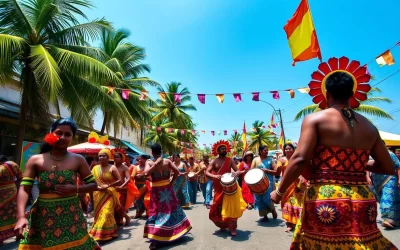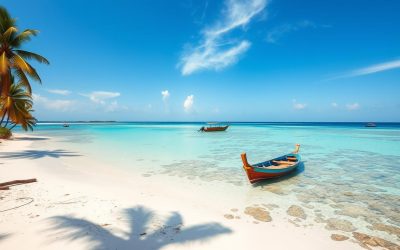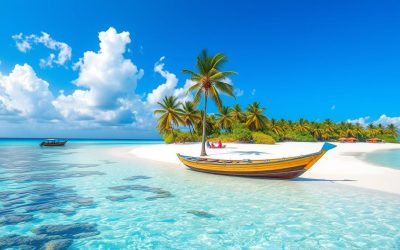✓ Accommodations✓ Flights✓ Rental Cars
You might be surprised to know that Lakshadweep, a small archipelago in the Arabian Sea, is home to a diverse linguistic landscape. Comprising 36 islands, this union territory of India has a rich cultural heritage shaped by its geographical isolation.
As you explore the linguistic identity of Lakshadweep, you’ll discover a complex tapestry of languages and dialects that reflect the territory’s history and cultural identity. The geographical isolation of the islands has contributed to the development of distinctive dialects and language variations not found on mainland India.
The linguistic heritage of Lakshadweep is an integral part of the islanders’ daily lives, and understanding this heritage is essential to appreciating the territory’s unique cultural identity.
The Geographical Context of Lakshadweep
Understanding Lakshadweep’s geographical context is essential to appreciating its cultural identity. The archipelago’s unique location and demographic characteristics have significantly influenced its cultural and linguistic diversity.
Location and Demographic Overview
Lakshadweep is an archipelago located off the coast of Kerala, India. It comprises 36 islands, with a total population of around 64,000 people. The islands are predominantly Islamic, with a culture deeply intertwined with Islamic heritage.

Cultural Significance of the Archipelago
The cultural significance of Lakshadweep is reflected in its unique blend of Islamic practices and pre-Islamic traditions. The matrilineal kinship system, economic activities like fishing and coconut cultivation, and the relative isolation of island communities have all contributed to the development of distinct cultural practices and linguistic diversity.
- The blend of Islamic and pre-Islamic traditions is evident in the social structures and linguistic terms.
- Economic activities have shaped the livelihood of island communities and contributed to specialized vocabulary.
- The relative isolation has fostered distinct cultural practices and linguistic diversity.
This unique cultural identity is a testament to Lakshadweep’s position as a cultural bridge between mainland India and Maldivian influences, showcasing a rich cultural diversity.
Linguistic Landscape of Lakshadweep
As you explore Lakshadweep, you’ll discover a rich tapestry of languages shaped by various influences. The islands’ linguistic diversity is a result of historical migration patterns, geographical isolation, and cultural exchange.
Distribution of Languages Across Islands
The distribution of languages across the islands of Lakshadweep varies significantly. You’ll find that Malayalam is widely spoken across most islands, while Mahl is predominantly spoken in Minicoy. Other dialects and languages also exist, reflecting the unique cultural identity of each island.

| Island | Primary Language | Other Dialects |
|---|---|---|
| Minicoy | Mahl | Malayalam, English |
| Kavaratti | Malayalam | Jeseri, English |
| Androth | Malayalam | Jeseri, Arabic |
Factors Influencing Linguistic Diversity
Several factors have contributed to the linguistic diversity of Lakshadweep. Historical migration from the Malabar Coast introduced Malayalam, which later evolved into distinct dialects due to geographical isolation. Islamic influence brought Arabic vocabulary into local languages. Limited inter-island interaction allowed unique linguistic features to develop. If you take time to visit different islands, you’ll notice the distinct linguistic characteristics shaped by trade connections and cultural exchange.
English: The Official Language
English is the official language in Lakshadweep, serving as a vital link between the islands and the rest of the world. As the primary medium of instruction in educational institutions, particularly at higher levels, English plays a crucial role in the academic and professional lives of the people.
Administrative Use of English
English is used extensively in administrative contexts, ensuring effective communication between the island administration and the central government. When you visit the islands, you’ll observe that official documents, government communications, and public services are typically provided in English.
English in Education and Government
English proficiency among the people of Lakshadweep has increased over time, particularly among younger generations. The college in Lakshadweep is affiliated with the University of Calicut, which further integrates the island’s education system with mainland India, opening up educational and professional opportunities for the residents. 
Malayalam and Its Dialects
Malayalam is a cornerstone of communication in Lakshadweep, with distinct dialects that reflect the islands’ cultural identity. As the primary language spoken across the islands, Malayalam facilitates daily interactions among the inhabitants.
Malayalam as a Lingua Franca
You’ll find that Malayalam serves as a common language, enabling effective communication among the islanders. This shared linguistic platform fosters a sense of community and facilitates social interactions.
Jeseri: The Distinctive Island Dialect
The Jeseri dialect, also known as Dweep Basha, is a unique variant of Malayalam spoken in the Amindivi and Laccadive islands. 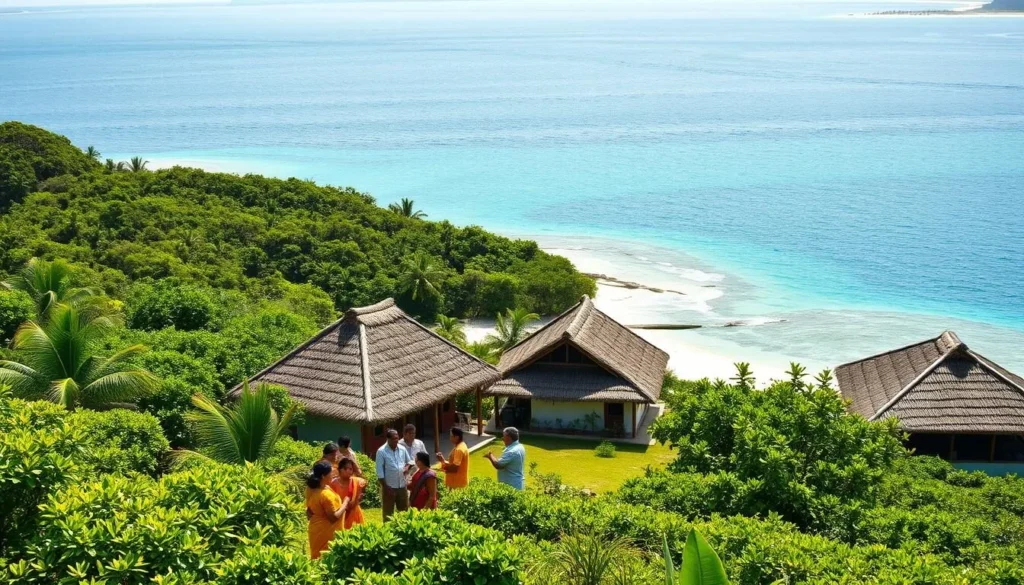 This dialect has evolved distinctively due to geographical isolation, resulting in differences in vocabulary and pronunciation. Jeseri is not just a means of communication; it’s also a marker of cultural identity for the people of Lakshadweep.
This dialect has evolved distinctively due to geographical isolation, resulting in differences in vocabulary and pronunciation. Jeseri is not just a means of communication; it’s also a marker of cultural identity for the people of Lakshadweep.
You’ll discover that Jeseri includes specialized terminology related to fishing, navigation, and coconut cultivation, reflecting the islanders’ way of life and their deep connection to the sea.
Mahl: The Language of Minicoy Island
You’ll find that Mahl, the language of Minicoy Island, is a significant part of the island’s identity. Mahl has distinct linguistic features that differentiate it from other languages spoken in the Lakshadweep islands.
Connection to Maldivian Culture
Mahl preserves Minicoy Island’s distinct heritage and maintains its connection to Maldivian culture rather than mainland Indian influences. This unique cultural connection is reflected in the language’s vocabulary and grammatical structures.
Unique Features of Mahl
Mahl has several unique features, including its own vocabulary, grammatical structures, and phonetic characteristics. Some key aspects of Mahl include:
- Using the Thaana script for writing, distinct from the Malayalam script used elsewhere in Lakshadweep.
- Being spoken by approximately 14% of Lakshadweep’s total population, primarily on Minicoy Island.
- Playing a crucial role in maintaining the cultural diversity and linguistic heritage of the territory.
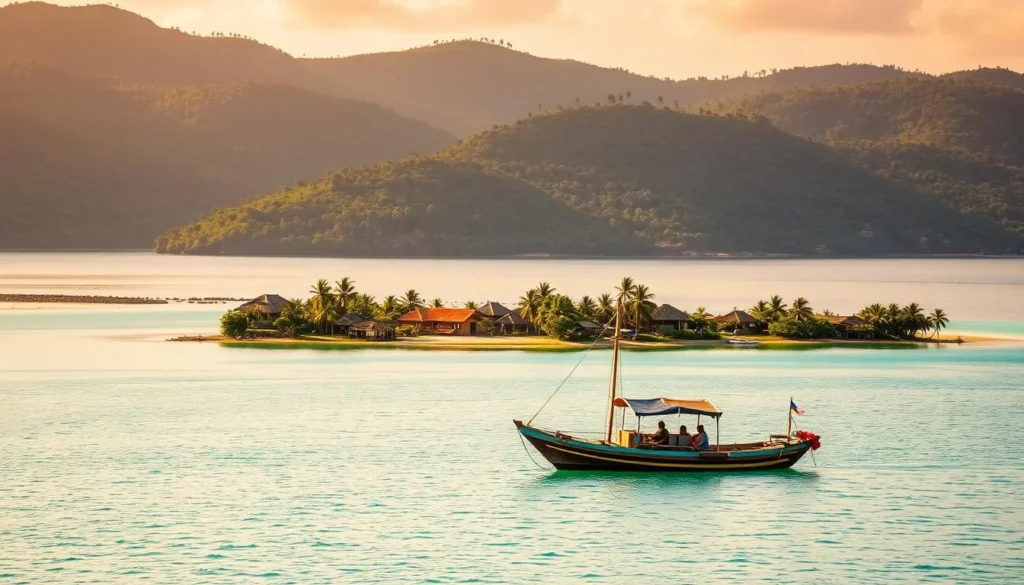
Lakshadweep (UT), India: Official and Widely Spoken Languages
Lakshadweep’s linguistic identity is shaped by its official language, English, and various local dialects. As a union territory, Lakshadweep maintains a unique linguistic profile.
Language Distribution Statistics
The linguistic diversity of Lakshadweep is reflected in the distribution of languages across its islands. You can see the prevalence of local languages like Jeseri and Mahl in the population.
| Language | Speakers | Percentage |
|---|---|---|
| Malayalam | 60,000 | 80% |
| Jeseri | 40,000 | 55% |
| Mahl | 10,000 | 15% |
Official Recognition and Status
English holds official status in Lakshadweep as the administrative language of the union territory. The government recognizes the linguistic diversity of Lakshadweep and supports the use of local languages in appropriate contexts.

Historical Evolution of Languages
As you explore the linguistic heritage of Lakshadweep, you’ll discover a rich history shaped by various influences. The islands’ strategic location in the Arabian Sea has made them a crossroads of cultural exchange.
Pre-Islamic Linguistic Influences
Before the arrival of Islam in the 7th century, the linguistic landscape of Lakshadweep was characterized by indigenous dialects. Certain pre-Islamic linguistic features persisted, particularly in traditional vocabulary related to fishing and navigation.
Impact of Islamic Culture on Language
The introduction of Islam marked a significant turning point in Lakshadweep’s linguistic history. As you take time visit mosques and religious institutions, you’ll notice the continuing influence of Arabic on local languages, especially in religious contexts and culture. This blend of influences has enriched the islands’ linguistic identity.
| Linguistic Feature | Pre-Islamic Influence | Islamic Influence |
|---|---|---|
| Vocabulary | Fishing, Navigation Terms | Arabic Loanwords |
| Script | Indigenous Scripts | Arabic Script |
| Cultural Practices | Traditional Customs | Islamic Education Systems |
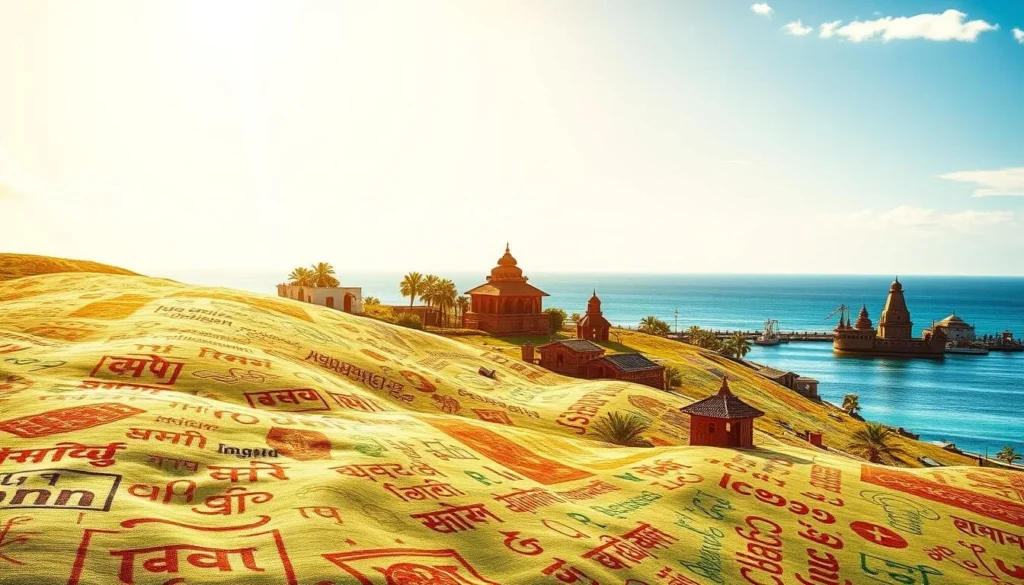
Scripts and Writing Systems
As you explore Lakshadweep, you’ll discover the diverse scripts and writing systems that reflect the islands’ rich cultural heritage. The use of different scripts is closely tied to the linguistic and cultural diversity of the islands.
Malayalam Script Usage
The Malayalam script is predominantly used for writing Malayalam, the widely spoken language in Lakshadweep. This script is an essential part of the cultural identity of the islanders, used in various contexts including education and literature. The Malayalam script has its own unique characteristics, distinguishing it from other scripts used in the region.
Arabic Script and Its Influence
The Arabic script holds significant cultural and religious importance in Lakshadweep, particularly in religious education and texts. Traditionally, Arabic was used for writing religious texts, and it was sometimes adapted for local languages. The union territory administration has taken initiatives to preserve the traditional Arabic script literacy, recognizing its significance in representing the Islamic heritage of the islands. The Thaana script, used for writing Dhivehi on Minicoy Island, is another unique aspect of the linguistic culture in Lakshadweep.
Language and Cultural Identity
As you explore the islands of Lakshadweep, you’ll discover how language plays a vital role in shaping the cultural identity of the island communities. The language variations between islands create micro-identities within the broader Lakshadweep culture.
Role of Language in Island Communities
Language is an integral part of life in Lakshadweep, with each island community maintaining its unique linguistic markers. For instance, traditional fishing terminology and techniques are handed down through family lines, highlighting the importance of language in maintaining cultural continuity.
Linguistic Markers of Cultural Heritage
The preservation of matrilineal family terms in local languages offers insights into the pre-Islamic history of the islands and their cultural evolution over the centuries. You’ll notice how vocabulary, pronunciation, and expressions vary across islands, serving as cultural heritage indicators that distinguish one island community from another.
Language Preservation Efforts
As you explore the linguistic landscape of Lakshadweep, you’ll notice a concerted effort to preserve the region’s rich linguistic heritage. This endeavor is multifaceted, involving various stakeholders and strategies.
Challenges to Indigenous Dialects
Preserving indigenous dialects poses significant challenges, including the influence of dominant languages and the erosion of traditional vocabulary. You may find that younger generations are less inclined to use local dialects, preferring more widely spoken languages.
Educational and Cultural Initiatives
To counter these challenges, educational institutions and cultural centers are implementing initiatives to document and promote local dialects. For instance, local schools are incorporating traditional knowledge into their curricula.
You can see that efforts to preserve linguistic diversity are underway, with a focus on activities that celebrate Lakshadweep’s linguistic heritage. These include language festivals, dialect documentation projects, and oral history collections.
| Initiative | Description | Impact |
|---|---|---|
| Language Festivals | Celebrations that promote local dialects through performances and competitions | Revitalizes interest in local dialects among younger generations |
| Dialect Documentation Projects | Systematic recording of local dialects for future reference | Preserves linguistic heritage for future generations |
| Oral History Collections | Collection of stories and expressions from community elders | Captures traditional knowledge and vocabulary |
These preservation efforts are crucial for maintaining the linguistic diversity of Lakshadweep. By engaging community elders and incorporating traditional knowledge into educational curricula, the islands are working to keep their linguistic traditions alive.
Multilingualism in Daily Life
As you explore Lakshadweep, you’ll notice the diverse linguistic landscape that reflects the islands’ cultural richness. The islands’ unique cultural heritage is characterized by the coexistence of various languages, creating a vibrant tapestry of multilingualism.
Code-Switching and Language Mixing
In daily interactions, locals often engage in code-switching and language mixing, seamlessly switching between languages like Malayalam, Mahl, and English. This linguistic flexibility is a hallmark of life in Lakshadweep, where multilingualism is a valuable skill. As a result, locals can effortlessly communicate with visitors and conduct daily transactions.
Language Use in Tourism and Commerce
The growing tourism industry has created a demand for multilingual skills, particularly in interacting with visitors through various tour packages. When you visit Lakshadweep, you’ll find that locals are proficient in languages useful for commerce and tourism, alongside traditional dialects. The time visit to markets and commercial areas reveals how language use shifts depending on whether transactions involve locals or tourists.
Language Policies and Government Initiatives
The Lakshadweep territory has implemented various language policies to preserve its rich linguistic heritage. These policies are crucial in maintaining the cultural identity of the island communities.
Official Language Policies
The official language policies in Lakshadweep are designed to promote the use of English for administrative purposes, while also supporting local dialects. This bilingual approach ensures effective communication both within the territory and with the outside world. When you visit Lakshadweep, you’ll experience firsthand the blend of languages that enriches the cultural landscape.
Support for Local Dialects
Efforts to preserve local dialects, such as Jeseri and Mahl, are underway, driven by both government initiatives and community efforts. Some key initiatives include:
- Collaboration between cultural institutions and educational bodies to document local dialects, creating essential resources like dictionaries and teaching materials.
- Incorporation of local languages into tourism promotion, enhancing the cultural experience for visitors and highlighting the territory’s linguistic diversity.
- Community-based initiatives that receive government support through cultural grants and educational programs, ensuring the continued use of local dialects in daily life.
These efforts reflect a recognition that local dialects are vital repositories of cultural knowledge and identity, enhancing the tourism experience while preserving heritage.
Conclusion: The Future of Languages in Lakshadweep
As you reflect on the linguistic landscape of Lakshadweep, you’ll notice the intricate balance between tradition and modernity. The linguistic diversity of this territory is a reflection of its rich cultural heritage and identity. As tourism grows, it presents both opportunities and challenges for language preservation. You see how traditional activities help preserve specialized vocabulary, while digital technology offers new tools for documenting and revitalizing local languages. The future of Lakshadweep’s languages will depend on balancing modernization with conscious preservation efforts. When you visit Lakshadweep, you’ll experience a unique linguistic landscape that continues to evolve while maintaining its distinctive character.
—
The above is subject to change.
Check back often to TRAVEL.COM for the latest travel tips and deals.

